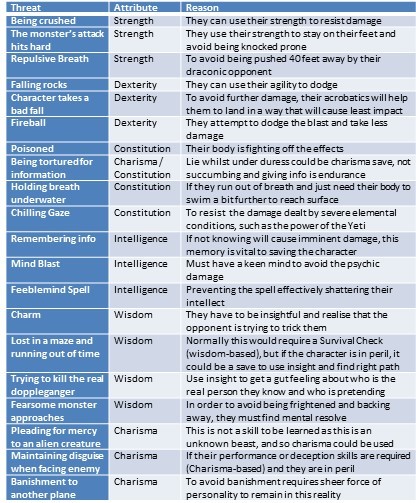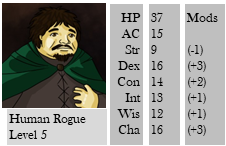Saving Throws
Recently I’ve been getting a few questions regarding the mechanics of D&D and how it works. The Player’s Handbook is excellent but it is just one explanation and sometimes what might make sense to one person might baffle another. So this series is about looking at an element of D&D and explaining it in more detail.
Let’s start with a description of Saving Throws taken from Wikipedia:
A saving throw is a roll of dice used to determine whether magic, poison, or various other types of attacks are
effective against a character or monster.
What are they for?
In D&D they are used to determine whether a character can resist or avoid the effects of a threat, such as a
trap, drinking poison or being charmed by another creature.
How do they work?
When the Dungeon Master (DM) reveals a threat to the player, they will be asked to roll a saving throw based on one of their character’s attributes. But which one?
Here are the 6 attributes as described by the Player’s Handbook, p.173:
Strength – measuring physical power
Dexterity – measuring agility
Constitution – measuring endurance
Intelligence – measuring reasoning and memory
Wisdom – measuring perception and insight
Charisma – measuring force of personality
I’ve listed 20 possible scenarios below and sorted them into the attribute the character needs to save against. Next to that is the reason why that attribute is the one being used.

How do you roll a saving throw?
You roll a saving throw against a difficulty class given by the DM. Often these are pre-determined; for example a monster’s attack effects (Beholder’s eye ray effects have a difficulty class is 16) or a magic user’s spells (8 + spell
caster’s ability modifier + proficiency bonus).
For difficulty classes not pre-determined, it is up to the DM to decide how difficult it is to avoid or
resist the threat. These range from very easy (difficulty class of 5) to nearly impossible (dc of 30). The DM should
also say what character attribute it is against.
Now you know what you are rolling against, you roll a d20 die and add you attribute modifier. If your character class has proficiency against that attribute, you add their proficiency number to the die roll. For example, a Level 3 Wizard with intelligence of 16 needs to try and pass an intelligence save. His intelligence modifier is +3 and as a
Level 3 wizard he can add his proficiency of 2. So his saving throw is 1d20 +5.
If the saving throw equals or is greater than the difficulty class, then they successfully save. This normally results in avoiding or reducing the effects that were threatening them.
So does it matter what attribute to use when making a saving throw?
Yes, it will matter to the character making the save. Each class has proficiency in saving throws for two attributes (see list on p.145 of the Player’s Handbook). Here is an example:

Meet Pevel, a Level 5 rogue from my online RP campaign, Agora Core. Rogues have proficiency in saving throws for Dexterity and Intelligence.
In this example, Pevel is being attacked by a Beholder (yikes!). The Beholder can attack with its many eye rays. Let’s blast Pevel 10 times with 2 different eye rays. The first time through, we will use the Petrification Ray, which requires
a Dexterity saving throw. Then we will repeat the dice rolls but this time, we will use the Sleep Ray, which requires
a Wisdom saving throw. For both, the difficulty class is 16.
Pevel’s rolls without adding modifiers are:
13, 5, 1, 6, 12, 7, 14, 20, 18, 17
Against the Petrification Ray, Pevel uses his Dexterity saving throw. As a Level 5 rogue, he add his proficiency, which is +3. So with his Dexterity modifier, his saving throw is 1d20 + 6.
That means his saving throws rolls are:
19, 11, Nat 1, 12, 18, 13, 20, Nat 20, 24, 23
Against the Sleep Ray, Pevel uses his Wisdom saving throw. As a Level 5 rogue he is not proficient in Wisdom, so simply adds his Wisdom modifier. He saving throw is 1d20 + 1. That means his saving throw rolls were:
14, 6, Nat 1, 7, 13, 8, 15, Nat 20, 19, 18
The difference between the two results shows how your chances of success vary depending on your character’s attributes and class. For the Dexterity saving throw in which Pevel was proficient, he successful rolled 16 or more 6/10 times. But for the Wisdom he only succeeded 3/10 times.
What if there is no threat?
If there is no threat, then the character is not reacting to imminent danger to their life. Any actions they take become an Ability Check instead. These still use the core 6 attributes, but more often than not use skills, which character can have proficiency in. For example, spotting a trap is a Perception Check (Wisdom-based), and working out how to disarm it with an Investigation Check (Intelligence-based).
